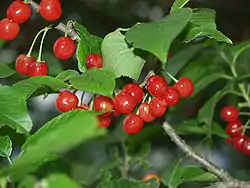桜ん坊
Japanese
| Kanji in this term | |
|---|---|
| 桜 | 坊 |
| さくら Grade: 5 |
ぼう Grade: S |
| yutōyomi | |
| Alternative spellings |
|---|
| 櫻ん坊 (kyūjitai) 桜桃 桜んぼ |
Etymology
/sakuranbau/ → /sakuranbɔː/ → /sakuranboː/
Etymology unclear. Leading theories include:
- Compound of 桜 (sakura, “cherry, cherry tree”) + の (no, possessive particle) + 坊 (bō, “boy, monk”, in reference to the tradition of shaven heads, indicating the smooth skin of the cherry fruit)
- Compound of 桜 (sakura, “cherry, cherry tree”) + 桃 (momo, “peach”, in reference to fruit in general; with a phonetic shift from /m/ to /b/ and shift from /bobo/ to /boː/)
Given the historical reading of sakuranbau, matching the historical bau reading of 坊, the initial derivation seems more likely.
The sakuranbō represents a regular historical shift from older sakuranbau. Sakuranbō with the long ō has been somewhat superseded in modern Japanese by the shortened reading sakuranbo.
The alternative 桜桃 spelling is an example of jukujikun, from Middle Chinese 櫻桃 (ʔˠɛŋ dɑu).
Pronunciation
Noun
Related terms
- 桜 (sakura): cherry tree
This article is issued from Wiktionary. The text is licensed under Creative Commons - Attribution - Sharealike. Additional terms may apply for the media files.
